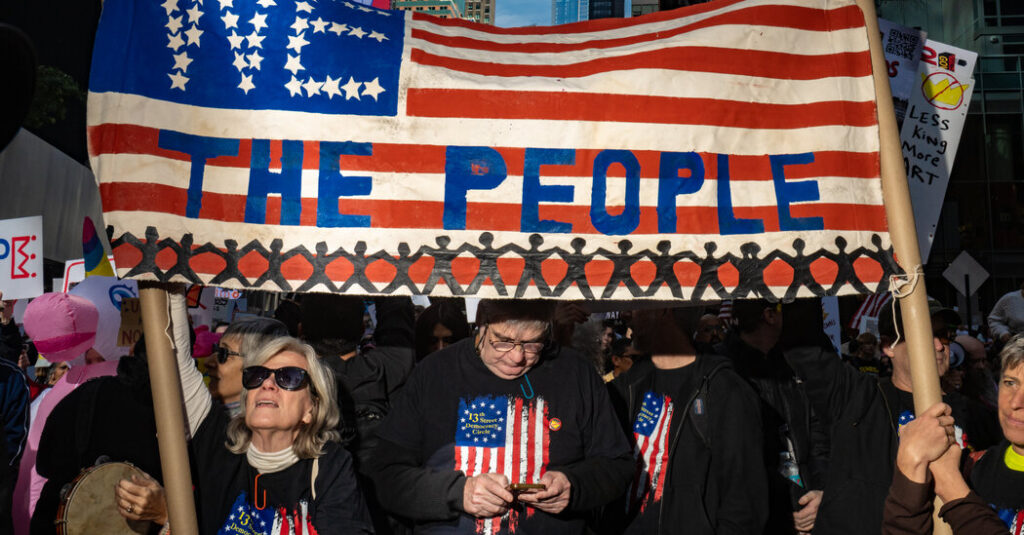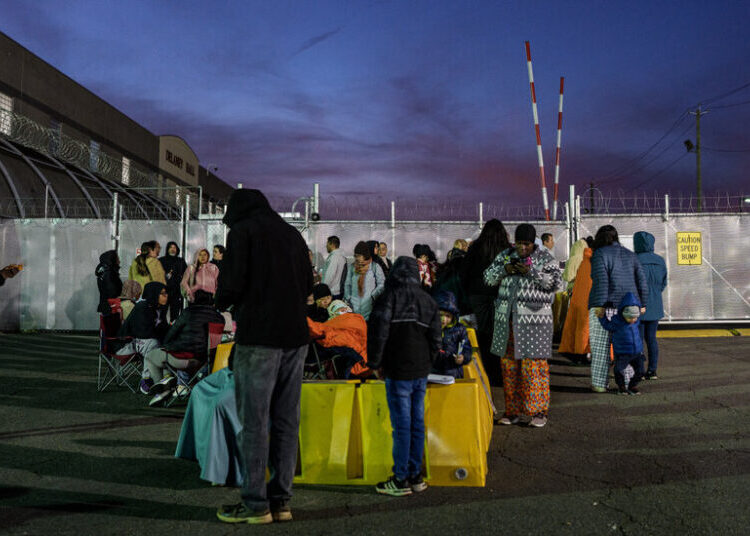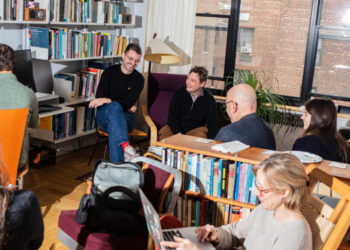The second Trump administration is already breaking through constitutional constraints on its power and subverting the rule of law. So why has the public response been so tepid?
Given America’s proud history as the world’s oldest constitutional democracy, we might have expected an enormous mobilization in response. And while there has been pushback — most notably, the No Kings movement drew an estimated five million people to the streets in October — the scale of the protests is still not as large as one might expect, given the severity of the threat. During President Trump’s first term, millions of people protested when the situation was far less dire.
One of the most notable and puzzling factors is the lack of young people. If you have participated in a No Kings protest or seen one in person, you have surely noticed the upward skew in the age of participants. Only 8 percent of Americans between the ages of 18 and 29 say they took part in the protests in October, compared with 13 percent of those age 65 and older, according to YouGov. Students are most conspicuous in their absence. The Rice University student newspaper counted only “about 30” students out of a crowd of more than 13,000 at a Houston protest, and Tulane’s newspaper documented “several” students at a protest of more than 10,000 in New Orleans.
These patterns mark a sharp reversal from the peak of the George Floyd protests in June 2020, when 13 percent of 18-to-29-year-olds reported attending an event in the previous month, the Pew Research Center found. At the time, people under 30 represented four in 10 of those protesting. The Floyd protests were not an anomaly. Teenagers and young adults have helped lead protest movements in the United States, such as those calling for civil rights and an end to the Vietnam War in the 1960s and 1970s. More recently, they were the core of protests against Israel’s war in Gaza after the attacks of Oct. 7, 2023. Internationally, young people played a key role in the Arab Spring and the resistance to China’s takeover of Hong Kong.
The absence of young people in protests against Mr. Trump’s authoritarianism matters, and not just for crowd counts. The No Kings protesters look like, and in many cases are, the same people who protested during Mr. Trump’s first term in office. But older people with signs are old news in the attention economy. As a result, the No Kings protests have had less effect on our politics than, say, the smaller Tea Party protests during Barack Obama’s first months as president, which helped spark a backlash before the 2010 midterm elections.
The most obvious potential explanations for this absence of young protesters do not hold up. First, there is no evidence that young people like Mr. Trump. Though they supported him at higher rates in 2024 than they did in his prior campaign, their approval of his job performance has plummeted during his time in office — one reason that his party performed poorly in recent elections in New Jersey and Virginia. At this point, seven in 10 people under 30 disapprove of how Mr. Trump is handling his job, the highest rate of any cohort.
Another explanation that might appeal to older people is the shift in attention toward online culture, but the existence of Instagram and other platforms didn’t stop more than one million students from walking out of school in the 2018 March for Our Lives protest against gun violence. Social-science evidence suggests that mobile phones and social media can actually facilitate protests by spreading information, helping with coordination and creating awareness of peer participation.
Another possibility is that young people are focused on other issues, such as the cost of living; the debate over the state of democracy may just seem too abstract or irrelevant to their lives. But that seems too simplistic. About one in four Americans ages 18 to 29 say they worry about someone they know being deported by the current administration, a much higher share than among the older Americans who dominate the ranks of recent protests, Pew found. Young people are also more likely than older people to say they worry about being asked to prove their citizenship. And the Trump administration is directly targeting young people through its actions against universities.
Finally, it is true, of course, that the fear of arrest, harassment or worse may be keeping some people away from Trump protests. But similar risks did not deter young people from protesting in greater numbers after Mr. Floyd’s killing or against the Gaza war. Nor did risks in Hong Kong, during the Arab Spring or in the United States during the civil rights and Vietnam War protests.
The more persuasive explanation for the relative lack of young people in the anti-Trump, pro-democracy movement is that they are demobilized and demoralized. But it would be a mistake to blame them for this attitude. Older generations should instead recognize that the world we have created does not seem to offer a viable path to making change.
Consider the experiences of the last few years. The racial justice movement that peaked in 2020 ended in disappointment and backlash. The Gaza protests provoked intense conflict without delivering clear political or policy victories for their organizers. Maybe most important, Mr. Trump himself is back in the White House, suggesting a futility to opposition and activism among young people who have only ever known him as the central figure in our politics. He first took the oath of office when today’s first-year college students were in elementary school.
The electoral choices offered to young people are not much better. Given the realities of our dysfunctional two-party system, the only alternative to a Trump-dominated G.O.P. is the Democratic Party, which is dominated by a decadent gerontocracy whose elites were more likely to attend a wedding in the Hamptons than a No Kings protest on the same day.
Young people also no doubt notice the cowardice of many individuals and institutions that have the most at stake from Mr. Trump’s attacks against democracy. Some prominent universities and law firms have struck lopsided deals with the Trump administration; several media organizations and tech companies have likewise reached dubious settlements that involve paying the president in some form. Most recently, many companies have been solicited by Mr. Trump to make donations for the new ballroom he is building after tearing down the East Wing of the White House. He has reportedly expressed amazement at how easily he bullied these law firms and donors. Even Congress is quiescent, with the former Trump strategist Steve Bannon comparing it to the Duma, the rubber-stamp Russian parliament.
The absence of young people from conventional protests is both a problem and a warning. The opposition to Mr. Trump’s authoritarian speed run requires new strategies that will engage a wider swath of the population. In Chicago, for instance, neighbors have formed community groups that use tools ranging from text messages to whistles to counter harrowing immigration raids. Whatever form the opposition takes, it must offer what conventional protest currently does not: a morally compelling form of resistance that can deliver results.
Brendan Nyhan is a professor in the Department of Government at Dartmouth College and a co-director of Bright Line Watch, a group that monitors the status of American democracy.
The Times is committed to publishing a diversity of letters to the editor. We’d like to hear what you think about this or any of our articles. Here are some tips. And here’s our email: [email protected].
Follow the New York Times Opinion section on Facebook, Instagram, TikTok, Bluesky, WhatsApp and Threads.
The post The Boomers Are Protesting Trump. Where Is Gen Z? appeared first on New York Times.




